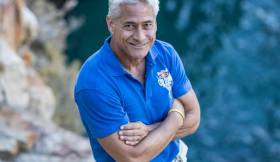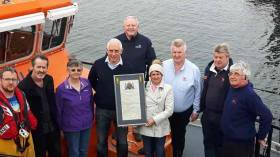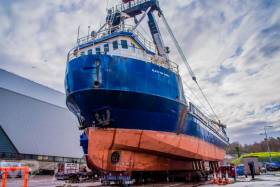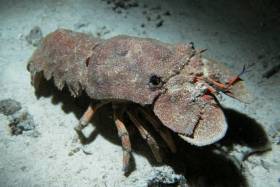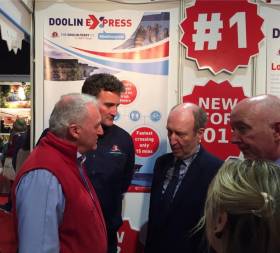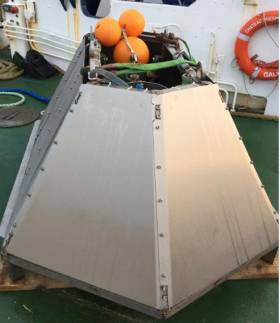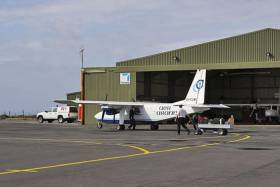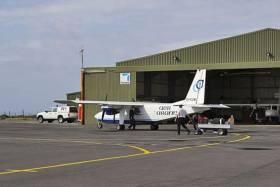Displaying items by tag: Aran Islands
Greg Louganis Set For Red Bull Cliff Diving On Inis Mór
#CliffDiving - World famous Olympic diver Greg Louganis will attend the Red Bull Cliff Diving World Series event in the Aran Islands later this month as the competition’s new sports director, as Galway Bay FM reports.
The five-time world champion and four-time Olympic gold medallist will arrive on the island of Inis Mór ahead of the globe’s cliff diving elite, who make their return to Poll na Péist — also known as the Serpent’s Lair — on the first stop of this year’s world tour, as previously reported on Afloat.ie.
All tickets for live spectators have been snapped up for the contest on Saturday 24 June, but the action will be livestreamed online via Red Bull TV.
#Aran&Arran – A passenger freightship that served the Aran Islands notably from Galway and a present day car ferry running to Arran, Scotland have similarities, writes Jehan Ashmore.
The custom-built Oileáin Árann (see photo) completed in 1991 at James Miller of St. Monans, on the Firth of Fife, served the Galway-Aran Islands route. The 416 gross tonnage vessel became the last ship to offer a 'direct passenger route' to and from the mid-west city, previously run by CIE’s Naomh Éanna.
Operator, O’Brien Shipping as previously reported sold the almost 40m long Oileáin Árann in 2006 to Icelandic owners Samskip. They converted the small ship to emerge as the ro-ro ferry Sæfari that trades in coastal waters to islands in northern Iceland.
As for the current car ferry operating to Arran, on the Firth of Clyde, the also custom-built Isle of Arran was too built in Scotland but on Clydeside at Ferguson Ailsa Ltd, Port Glasgow. The 3,296 gross tonnage relief ferry operates Ardrossan-Brodick (Arran: see Scotland in miniature) during the summer months. In addition Caledonian Isles operates year round for Caledonian MacBrayne (CalMac).
Towards the end of last month, the almost 85m Isle of Arran resumed seasonal Ardrossan-Campbeltown sailings on the Mull of Kintyre. This is the second year since the most southernmost CalMac route was given permanent status following a three year pilot trial. This was to develop traffic and boost tourism to the isolated peninsula a mere 11 nautical miles from Northern Ireland.
Likewise of the former Oileáin Árann, the CalMac pair feature twin funnels and have their names in Scots Gealic. Isle of Aran is translated to Eilean Arainn and as for Caledonian Isles this is Eileanan Chaledonia. The English names are displayed on the hull, while the bi-lingual versions are to seen on the superstructure.
Both these car ferries are to be replaced when the first of a pair of 102m dual-fuel (diesel and LPG) ferries are planned for year-round service for Arran and the Uig Triangle. Construction of the €97m newbuilds is taking place in Port Glasgow at the Ferguson Marine Engineering Limited’s (FMEL) shipyard. The design of these sleek looking newbuilds will again feature twin funnels.
The first newbuild is expected to enter service in early 2018, with the sister following a few months later. Each ferry will carry 127 cars or 16 HGVs or a combination of both and up to 1,000 passengers.
From Oileáin Árann to Icelandic Sæfari
#ÁrannSæfari - The return of Ireland's largest domestic freighter, Bláth na Mara, this week on the Galway-Aran Islands routes recalls memories of a predecessor that remains in service albeit in Icelandic waters, writes Jehan Ashmore.
The predecessor is not to be mistaken for the Naomh Éanna, the veteran vessel dating to 1958 was decommissioned on the CIE operated service that closed in 1988. Unfortunately, the Dublin built ship remains languishing in the capital despite plans to bring her back to Galway. As previously reported she again faces the threat of scrapping!
In fact the last such ship serving scheduled Aran Islands services from Galway Port was the Oileáin Árann. Notably, this vessel was also the final ship to carry ‘passengers’ from the city on a service that combined freight when operated by Doolin based O’Brien Shipping.
At 416 gross tonnage Oileáin Árann (photo) is larger to the Bláth na Mara with a tonnage of 330. This 36m freight-only vessel operates Ireland’s longest distance domestic freight route run by Lasta Mara Teoranta that took over the Government contracted service in 2005. In the following year Oileáin Árann was sold to the then Icelandic owned operator, Samskip which renamed the ship Sæfari.
The almost 40m Sæfari, is part of a giant global logistics company based in Rotterdam from where subsidiary Samskip Multimodal BV operate lo-lo container feeder services to the island of Ireland. Tonight in Dublin Port is berthed their Samskip Express which arrived from Rotterdam. The next port of call is Belview, the main terminal for the Port of Waterford.
On introduction to Irish owners of the Oileáin Árann in 1992, the vessel presented a rather unusual looking appearance on the Aran run given a forward superstructure accommodating passengers complete with a tower-like wheelhouse a deck above. This deck arrangement resembled that of an offshore oil supply support /standby ship and as if based out of Aberdeen to serve in the North Sea.
Oileáin Árann was a custom-built passenger freight ship ordered in the UK, that firstly involved Brombrough based McTay Marine, England, to build the hull. As for the balance of work this was contracted to their then Scottish associates James Miller of St. Monans, Fife. Both these firms are no longer in business but perhaps there is some merit to my theory as to the background of the Fife yard's naval architecture given the Forth of Fife remains synonymous with the oil sector. This is where anchored inactive North Sea rig platforms can be found and BP’s (Crude Oil) Hound Point Marine Terminal.
The Oileáin Árann loaded cargo on board using a deck-mounted crane located on the aft freight deck. Also located here are twin funnels lining along the ships side. It was during a visit to Galway Port, that I observed from the outer pier the dual-purpose vessel depart through the Dun Aengus Dock. These days such services (freight-only) take place at the outer pier.
Under current owners, Samskip undertook rebuilding the vessel that involved an enlarged superstructure. The conversion included work at the aft deck with the fitting of a stern-loading vehicle ramp and a side-loading door for additional ro-ro access.
So the former Aran Islands ship now car-ferry Sæfari operates scheduled trips from Dalvík to Hrisey and Grímsey, Iceland´s northernmost inhabited island of around 100 persons. Most of whom are employed in the fishing industry. Asides the attraction of wildlife for tourists, the Arctic Circle runs right through the middle of Grímsey. Those who enter the Circle receive a special illuminated certificate to confirm their adventure.
As far as current Irish operations are concerned, the recent relief ro-ro ferry Chateau-Thierry (that stood in for Bláth na Mara) has a bow-loading vehicle ramp and a deck mounted crane. Galway port however does not feature a slipway nor indeed a linkspan for more conventional tonnage such as the Sæfari.
RNLI Award for Gallantry Returned to Aran Islands
The grandnephew of an RNLI bowman who was awarded the charity’s bronze medal for gallantry for his part in the daring rescue of 12 people from a Greek freighter back in 1938, has made a visit from the UK to Galway this week to present the Aran Islands lifeboat crew with a precious gift.
John Harwood’s grand uncle Patrick Flaherty was the bowman of the Galway Bay (now Aran Islands RNLI) motor lifeboat which was called out on the night of the 16-17 August 1938. He was subsequently awarded in recognition of his meritorious conduct when together with four other men he courageously manned a small boat and rescued the crew of 12 of the steam trawler ‘Nogi’ which had run aground near Straw Island Lighthouse, Aran Isles, during a strong westerly-south westerly wind with a very heavy sea.
An online article describes how a boat from the Hatano with four men went to her rescue and at once got into difficulties. The lifeboat went first to the small boat, the rowlock of which caught in the fender of the lifeboat, and there was danger of a serious accident. The motor mechanic jumped aboard the boat and smashed the rowlock with a hatchet. The four men were rescued and their boat towed away. It was impossible for the lifeboat to get alongside the Nogi but five of her crew manned the small boat; it was lowered by a rope down to the Nogi and in two journeys rescued the 11 men on board her. A member of the Nogi's crew had been swept away in the trawler's boat when she struck. His boots were found on an island, but it was only after eight hours' search that the man was found dazed and exhausted. The whole rescue had taken over 14 hours.
When John’s uncle Paddy who lived in the north west of England and worked most of his life as a miner, died in 1998, he left John his father’s citation for the bronze medal which is written on vellum.
 Historic Vellum returned to the Aran Islands
Historic Vellum returned to the Aran Islands
‘This always had pride of place in my uncle’s house,’ John explained, ‘and as a child he often told me the story about how his father and I think his older brother took part in the rescue. He also regaled me with tales of his life on Aran, particularly his connection with the sea. This influenced me in later life to love the sea and along with my wife I have had a 30 year passion for the sea as a diver and yachtsman.’
John’s visit to Galway yesterday evening (Wednesday 19 April) follows his decision to return the citation to Aran Islands RNLI.
‘As time marches on, I realise that there will be no one to appreciate the award when my wife and I are no longer here, so I think it is high time that the award is returned to the Aran Islands where it belongs. I believe that my uncle may still have family on the Islands. I think the award should lie with them or with the lifeboat station.’
John and his wife Mary met members of both Aran Islands and Galway RNLI in Rosaveal yesterday evening before John presented the citation on vellum to Aran Islands RNLI Coxswain John O’Donnell.
‘We are extremely touched by John and Mary’s generous gesture to place what is their precious heirloom into the care of Aran Islands lifeboat station. RNLI medals for gallantry are rare and are presented for acts of bravery and this was certainly the case on the night the lifeboat carried out the rescue of the Nogi in 1938. We are very grateful to receive this award from John and Mary and can assure them it will take pride of place in his granduncle Patrick Flaherty’s lifeboat station.’
#AranFreighters - Ireland’s Iargest domestic coastal cargoship that returned from hull works carried out in Co. Donegal earlier this month has yet to re-enter Galway-Aran Islands services, writes Jehan Ashmore.
The 330 gross tonnage cargoship Bláth na Mara normally serves as an essential life-line providing supplies to island communities of all three Aran Islands, Inishmore, Inis Meain and Inis Oirr.
Instead Chateau Thierry which has a roll on / roll-off capabilities is currently covering in as relief cargoship on the Galway route. As there is no slipway facilities, cargo loading will involve use of a deck-mounted crane. In the meantime this replacement vessel has allowed ongoing maintenance work to continue on Bláth na Mara while docked in Galway Docks.
Operators of both freighters, Lasta Mara Teoranta normally deploy Chateau Thierry, a former US tank landing craft (see report photo) on a second service to Aran Islands from Rossaveel. This service conveys trucks, excavators and heavy plant and machinery.
The Government contracted service to the Aran Islands have been operated by Lasta Mara for almost two decades. As the sole operator of freight-only vessels this involves carrying a diverse range of cargoes: from all kinds of food, household items, furniture, coal and vehicles hoisted on board and also livestock. This leaves several other passenger-only operators to serve the islands.
The Galway registered Bláth na Mara based out of the mainland homeport had works completed at Mooney Boats in Killybegs. The call to the yard involved Bláth na Mara using the boat-lift raised to the top of the quayside from where the 36m freighter was transferred on a rail-system to the workshop. This enabled shot blasting and painting of the hull. The works also saw anodes supplied and fitted to the hull.
Cargo loading in Galway Port takes place at the outer pier where Lasta Mara Teo has a warehouse. This is from where the 28m Chateau Thierry departed this morning on the islands cargo feeder service.
Otherwise the routine use of Bláth na Mara involves a single cargo derrick swung from an A-frame foremast. Containers are stowed onto the aft-deck. This layout gives the ship a distinctive profile as the wheelhouse is located at the bow unlike the vast majority of cargoships.
On completion of loading the hard-working coastal freighter heads first to the largest island, Inishmore at Kilronan Harbour. Having discharged cargoes on Inis Mor the service continues to neighbouring Inis Meain and Inis Oirr.
Rare Slipper Lobster Found Off Aran Islands
#MarineWildlife - The Galway Atlantaquaria is currently caring for an extremely rare slipper lobster found in Galway Bay off the Aran Islands in recent days.
According to the Marine Institute, this is the first recorded landing of the warm ocean species at this latitude in the North Atlantic, after previous reports Kerry and Cork in the last decade.
The latest find was landed by skipper John Connolly of the fishing vessel Connacht Ranger from Kilronan on Inis Mór, and landed into Rossaveal, where it was later identified by Terlich Smith of the Marine Institute.
"My nieces and nephews were very excited about the slipper lobster, and named it Tréan, which is an old Irish word for hardy and brave and usually associated with warriors,” said Connolly.
“The fact it was so small, came so far north, and survived being towed up in a big net full of spurdogs, stones and prawns does make the name seem pretty apt.”
The Galway Atlantaquaria is now caring for the 72mm exotic lobster, which is progressing well after a week in quarantine.
#FastestCrossing – A newly acquired passenger-only ferry is to offer the fastest ever crossing time to the Aran Islands, when Doolin Ferry introduce a highspeed craft just one month after the seasonal service resumes, writes Jehan Ashmore.
Speaking to Afloat at Holiday World Show, Dublin, Liam O’Brien, Director of Doolin Ferries, commented that the 200-passenger ferry, Doolin Express will from April, offer the fastest crossing time to the Aran Islands in just 15 minutes. The new ferry will considerably reduce the journey passage by shaving off 20 minutes from the old 35 crossing time on the Doolin Pier-Inis Oírr service.
The west Clare based operator acquired the fastferry, Blanche Hermine from France operator, Vedettes du Golfe. The craft had served islands in the Golfe du Morbihan, an almost enclosed sea near Vannes in southern Brittany.
Doolin Express will sail at a minimum speed of 19 knots on the service to Inis Oírr, the smallest but closest of the three Aran Islands to the mainland. Neighbouring islands are also served by the company to Inis Meáin and further west Inis Mór, the largest of these Atlantic isles off Galway Bay.
A rival operator also serves from Doolin along with those running from Rossaveal, Connemara and a freight-only link from Galway Port.
When the new ferry, Doolin Express enters service, she will become the largest of the fleet to carry passengers. Tranquility takes 100 passengers and Queen of Aran, a veteran on the west coast service with almost the same capacity.
Doolin Ferry (O’Brien Line) a family run business founded in 1970, also runs excursion trips by Cailin Or with 72 passengers to the spectacular Cliffs of Moher. This location is one of the many highlights dotted along the western seaboard.
In recent years the rugged coast stretching from counties Cork to Donegal has been branded as the Wild Atlantic Way. This has assisted in boosting tourism numbers and notably by targeting overseas visitors.
#MarineNotice - The latest Marine Notice from the Department of Transport, Tourism and Sport (DTTAS) advises that University College Dublin is running a scientific wave measurement campaign deploying a bed mounted ADCP at Inis Meáin in the Aran Islands s of yesterday (Saturday 28 January).
The ADCP, or acoustic Doppler current profiler, is deployed in a seabed-mounted frame at a depth of around 40 metres, with a ground line between the frame and a clump weight also rested on the seabed.
The purpose of the deployment is for measurement of waves and currents of the coast of Inis Meáin. This is a temporary deployment and it is proposed that the ADCP will be recovered before 15 May this year.
Co-ordinates and a map showing the deployment location are included in Marine Notice No 2 of 2017, a PDF of which is available to read or download HERE.
Contract Signed For Aran Islands Flights
#AranIslands - Galway Bay FM reports that a new contract for the decades-old aeroplane service to the Aran Islands has been signed.
As previously reported on Afloat.ie, the long-awaited PSO contract will see flights continue between the Galway Bay islands and the mainland at South Connemara till at least the end of 2020.
The agreement follows months of uncertainly over the future of the air link due to costs on the route.
Only two weeks ago, local Senator Trevor O’Clochartaigh queried the contract’s imposition of additional fees for passengers on unscheduled flights.
Senator Raises Issue Of Levy For Unscheduled Aran Islands Flights
#AranIslands - Issues remain with the new contract for Aran Islands air services, according to one local senator.
As Galway Bay FM reports, Senator Trevor O’Clochartaigh says the new PSO agreement imposes additional fees on flights not specified on the schedule.
The situation means that passengers on an extra flight for a funeral or in other exceptional circumstances might have to pay more than €30 extra for their seat.
Only three weeks ago, residents in the Galway Bay islands – who have also recently faced the prospect of losing their winter ferry service – were given certainly that their air link to the mainland would continue till at least the end of 2020.
But O’Clochartaigh says Gaeltacht Minister Seán Kyne can still act to make arrangements so that islanders are not left out of pocket. Galway Bay FM has more on the story HERE.




























